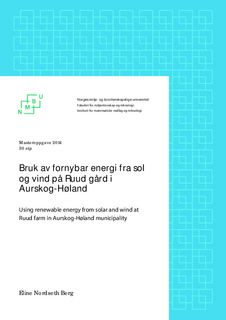| dc.contributor.author | Berg, Eline Nordseth | |
| dc.date.accessioned | 2015-03-10T11:51:30Z | |
| dc.date.available | 2015-03-10T11:51:30Z | |
| dc.date.copyright | 2014 | |
| dc.date.issued | 2015-03-10 | |
| dc.identifier.uri | http://hdl.handle.net/11250/278803 | |
| dc.description.abstract | This study examines the electric energy production from renewable energy technologies on
a farm in Aurskog-Høland, in Akershus county, Norway. The renewable energy technologies
are the use of wind turbine and solar cells. The study is part of a project organized by
the Institute for Energy Technology and the Norwegian Farmers’ Union, Project sun and
wind on Norwegian farms.
The aim is to look at the correspondence between the profiles of annual energy production
and the annual consumption profile for the farm. In addition there are two constraints
that must be taken into account. Firstly, the annual production cannot exceed the annual
consumption. Secondly there is a transmission constraint in the low voltage grid of 40
kW which cannot be exceeded.
The chosen turbine is Endurance Wind Power E-3120 with 50 kW installed power.
Average wind speed at the site is 4.3 m/s (measured at 18 meters height), data is
supplied by Kjeller vindteknikk. The prevailing wind direction is from the south-southwest.
Simulation provides an annual production of 89 MWh from the wind turbine.
The solar cell module selected is SunPower’s E20-327. The module has high efficiency
and high performance ratio. Annual solar radiation at the site is 932 kWh/m 2 against a
horizontal surface. The data on solar irradiance is obtained from PVgis. Production from
the solar cell modules are simulated in PVsyst. This software allows for determining type
of inverter, number of modules and layout of these modules. The roof of the new barn
and the tool shed is thought covered by solar modules.
The annual consumption of the farm is 136 MWh. The consumption profile is a combination
of estimated and recorded consumption.
Production from the wind turbine and solar cells are combined in eight different ways.
Several combinations are irrelevant because the annual production is too high. The
combinations that rely only on solar cells will face similar challenges in that the
production profiles corresponds poorly with the consumption, and should be combined
with a form of storage device. Energy production from the wind turbine covers 65 %
of the annual consumption and rarely conflicts with the transfer constraint in the low
voltage grid.
The optimal production combination with the applicable constraints, is a combination of
the wind turbine and a small solar cell plant placed east on the new barn. The combination
has a total installed capacity of 61 kW, and covers 74 % of the annual consumption with
an output of 101 MWh. This combination has only 65 hours in which the production
conflicts with the transfer constraint, a challenge that is manageable. | nb_NO |
| dc.language.iso | nob | nb_NO |
| dc.publisher | Norwegian University of Life Sciences, Ås | |
| dc.rights | Navngivelse 3.0 Norge | * |
| dc.rights.uri | http://creativecommons.org/licenses/by/3.0/no/ | * |
| dc.subject | Electricity consumption | nb_NO |
| dc.subject | Norwegian farm | nb_NO |
| dc.subject | Wind turbine | nb_NO |
| dc.subject | PV-plant | nb_NO |
| dc.title | Bruk av fornybar energi fra sol og vind på Ruud gård i Aurskog-Høland | nb_NO |
| dc.title.alternative | Using renewable energy from solar and wind at Ruud farm in Aurskog-Høland municipality | nb_NO |
| dc.type | Master thesis | nb_NO |
| dc.subject.nsi | VDP::Mathematics and natural science: 400 | nb_NO |
| dc.subject.nsi | VDP::Technology: 500 | nb_NO |
| dc.subject.nsi | VDP::Agriculture and fishery disciplines: 900 | nb_NO |
| dc.source.pagenumber | 101 | nb_NO |
| dc.description.localcode | M-MF | nb_NO |

